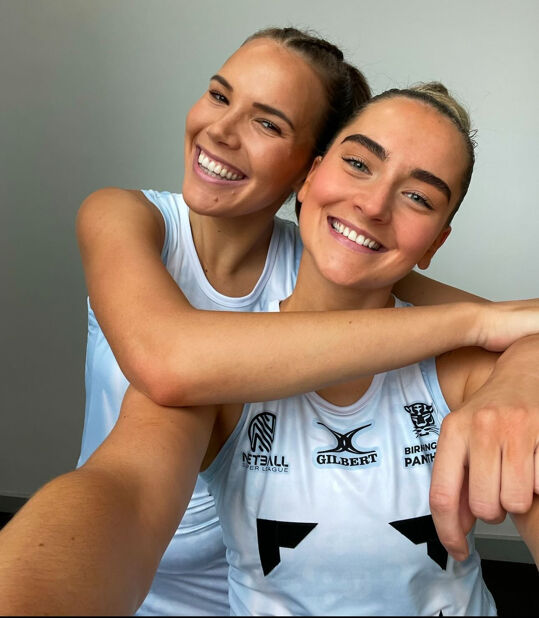Our fashion courses provide opportunities to get hands-on industry experience and work with a range of sports brands such as Gill Marine and Birmingham Panthers, preparing students like Zoe for career success.
In this blog, we sat down with BCU Fashion student Zoe, who shared her incredible journey working with these renowned brands and how it has shaped her career goals.
Can you tell us about your experience working with Gill Marine, Superdry, and Birmingham Panthers? What kind of projects did you work on?
It’s been an amazing journey. I started with a design competition for Gill Marine during my first year, where I redesigned an aspect of their OS1 offshore sailing coat. My idea for the cuff system stood out, and I won the competition, which led to a four-week internship at their Long Eaton headquarters over Christmas. I got involved in everything—from design meetings and quality control to fabric testing in their lab, which was really cool. I even worked on redesigning one of their multipurpose jackets.
With Superdry, I worked on a conceptual live industry brief that involved creating a portfolio and a collection inspired by music culture and material forecasting. I chose Frank Ocean as my inspiration, which made the project really interesting.
The Birmingham Panthers project was a design competition to create a new kit for the debut team. My friend and I combined our designs and collaborated over the summer to finalise the kit with Gilbert’s headquarters in Hastings, where I had the opportunity to tour their facilities and make final decisions on kit details and merchandise.
 How did these industry experiences help you understand the design and performance needs of sportswear and fashion?
How did these industry experiences help you understand the design and performance needs of sportswear and fashion?
Designing for sportswear is very different from fashion. With fashion, you can compromise on fit or comfort for aesthetics, but with sportswear, performance is everything. You have to think about material selection, flexibility, ventilation, and how the garment feels in action. Gill Marine, for example, focuses heavily on fabric testing to ensure their offshore coats can withstand extreme conditions. Their coats are meant to outlast the wearer—literally! Superdry, on the other hand, was more about aesthetic appeal and streetwear influence.
What were some key skills you developed during your placements that are essential for a career in the sportswear industry?
Technical skills were a big focus. I realised that while I love illustrations and concept designs, the industry values technical knowledge just as much. I learned about manual pattern cutting, garment construction, and fabric testing. I also gained proficiency in Illustrator, Photoshop, and InDesign, which we practiced in workshops. These skills are essential for understanding how designs translate into real garments.
Working with established brands like Gill Marine and Superdry, what did you learn about the industry’s expectations for designers?
The industry is looking for well-rounded designers who aren’t just creative but also technically skilled. Gill Marine, for example, had a very small but highly technical design team that focused on garment technology and fabric testing. I was surprised that they didn’t have people just doing illustrations—everyone had a strong understanding of garment construction. Superdry, on the other hand, had a bigger team where aesthetics played a bigger role.
What role does innovation and technology play in designing sportswear, based on your industry experiences?
Technology is a game-changer in sportswear design. At Gill Marine, I witnessed in-house waterproof testing using hydrostatic head machines that blast water at the fabric to test its durability. If the fabric bursts, it’s considered a fail. This level of testing ensures that the product meets extreme performance requirements. Understanding these processes helps designers create garments that are both functional and durable.
Sportswear Design
Find out more about our course
How important is industry experience for students looking to break into Sportswear Design?
It’s crucial. Industry exposure helps you understand real-world expectations and allows you to see how different teams collaborate. I’ve learned so much just by being in these environments. Whether it’s working on quality control, assisting in fabric testing, or sitting in design meetings, every experience adds value. I would tell any student—say yes to everything. You never know where an opportunity might take you.
What advice would you give to future students considering the new Sportswear Design course?
Try everything. Say yes to competitions and internships, even if it’s something outside your comfort zone. I wasn’t initially sure about applying for the Gill Marine competition, but my lecturer encouraged me, and it turned out to be one of the best decisions I made. Be open to learning new skills and exploring different areas of design—you’ll discover what you truly enjoy.
What trends or changes in the industry should aspiring sportswear designers be aware of?
Sportswear is becoming more versatile and accessible. It’s no longer just about athletes—there’s a growing trend towards athleisure, where performance meets everyday wear. Consumers want multipurpose garments that look stylish but also perform well. As a designer, you need to think about both aesthetics and function to meet this demand.
How have these experiences shaped your own career goals, and what’s next for you?
These experiences have definitely broadened my perspective. I never really considered sportswear initially, but after working on these projects, I’m excited to explore more in this field. I’m particularly interested in applying for an internship at Gymshark in Solihull, which would be amazing. I’ve realised that staying open to opportunities has led me to discover new passions and career paths.
